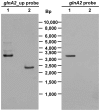Glutamine synthetase 2 is not essential for biosynthesis of compatible solutes in Halobacillus halophilus
- PMID: 24782854
- PMCID: PMC3995056
- DOI: 10.3389/fmicb.2014.00168
Glutamine synthetase 2 is not essential for biosynthesis of compatible solutes in Halobacillus halophilus
Abstract
Halobacillus halophilus, a moderately halophilic bacterium isolated from salt marshes, produces various compatible solutes to cope with osmotic stress. Glutamate and glutamine are dominant compatible solutes at mild salinities. Glutamine synthetase activity in cell suspensions of Halobacillus halophilus wild type was shown to be salt dependent and chloride modulated. A possible candidate to catalyze glutamine synthesis is glutamine synthetase A2, whose transcription is stimulated by chloride. To address the role of GlnA2 in the biosynthesis of the osmolytes glutamate and glutamine, a deletion mutant (ΔglnA2) was generated and characterized in detail. We compared the pool of compatible solutes and performed transcriptional analyses of the principal genes controlling the solute production in the wild type strain and the deletion mutant. These measurements did not confirm the hypothesized role of GlnA2 in the osmolyte production. Most likely the presence of another, yet to be identified enzyme has the main contribution in the measured activity in crude extracts and probably determines the total chloride-modulated profile. The role of GlnA2 remains to be elucidated.
Keywords: Halobacillus halophilus; compatible solutes; glutamine synthetase; halophile; osmoregulation.
Figures







Similar articles
-
Biochemical and molecular characterization of the biosynthesis of glutamine and glutamate, two major compatible solutes in the moderately halophilic bacterium Halobacillus halophilus.J Bacteriol. 2006 Oct;188(19):6808-15. doi: 10.1128/JB.00781-06. J Bacteriol. 2006. PMID: 16980483 Free PMC article.
-
Regulation of osmoadaptation in the moderate halophile Halobacillus halophilus: chloride, glutamate and switching osmolyte strategies.Saline Syst. 2008 Apr 28;4:4. doi: 10.1186/1746-1448-4-4. Saline Syst. 2008. PMID: 18442383 Free PMC article.
-
Chloride and organic osmolytes: a hybrid strategy to cope with elevated salinities by the moderately halophilic, chloride-dependent bacterium Halobacillus halophilus.Environ Microbiol. 2013 May;15(5):1619-33. doi: 10.1111/j.1462-2920.2012.02770.x. Epub 2012 May 14. Environ Microbiol. 2013. PMID: 22583374
-
Molecular Mechanisms of Adaptation of the Moderately Halophilic Bacterium Halobacillis halophilus to Its Environment.Life (Basel). 2013 Feb 27;3(1):234-43. doi: 10.3390/life3010234. Life (Basel). 2013. PMID: 25371341 Free PMC article. Review.
-
[Study progress on compatible solutes in moderately halophilic bacteria].Wei Sheng Wu Xue Bao. 2007 Oct;47(5):937-41. Wei Sheng Wu Xue Bao. 2007. PMID: 18062278 Review. Chinese.
Cited by
-
Physiological and genomic insights into abiotic stress of halophilic archaeon Natrinema altunense 4.1R isolated from a saline ecosystem of Tunisian desert.Genetica. 2023 Apr;151(2):133-152. doi: 10.1007/s10709-023-00182-0. Epub 2023 Feb 16. Genetica. 2023. PMID: 36795306 Free PMC article.
-
Preface to the proceedings of Halophiles 2013.Front Microbiol. 2015 Apr 22;6:341. doi: 10.3389/fmicb.2015.00341. eCollection 2015. Front Microbiol. 2015. PMID: 25954264 Free PMC article. No abstract available.
References
-
- Ausubel F. M., Brent R., Kingston R. E., Moore D. D., Seidman J. G., Smith J. A., et al. (1992). Current Protocols in Molecular Biology. New York: Green Publishing and Wiley-Interscience; 10.1002/0471142727 - DOI
-
- Cánovas D., Vargas C., Calderon M. I., Ventosa A., Nieto J. J. (1998). Characterization of the genes for the biosynthesis of the compatible solute ectoine in the moderately halophilic bacterium Halomonas elongata DSM 3043. Syst. Appl. Microbiol. 21 487–497 10.1016/S0723-2020(98)80060-X - DOI - PubMed
LinkOut - more resources
Full Text Sources
Other Literature Sources

